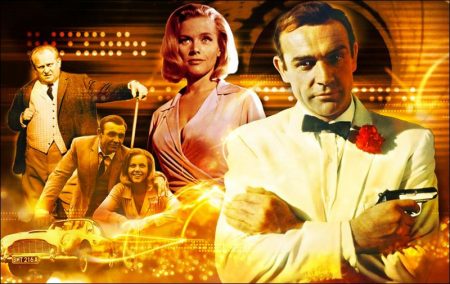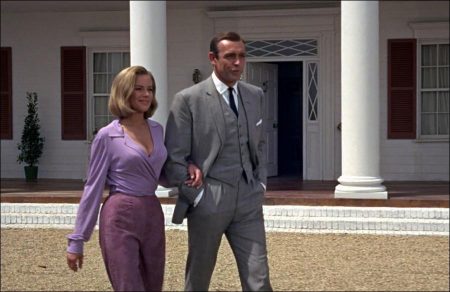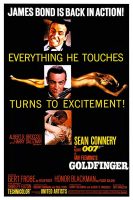Taglines: Everything he touches turns to excitement!
Goldfinger movie storyline. Powerful businessman Auric Goldfinger plans an operation he calls the Grand Slam. It plans to plunder Fort Knox, the heart of the world economy, where all countries’ gold reserves are stored and protected by a military base.
The task of blocking him is given to agent 007, James Bond, of the British Secret Service. Bond follows Goldfinger with the help of his outstanding Aston Martin. The obstacles that Bond must overcome are the dumb servant of Goldfinger’s men, the dumb servant Oddjob, the beautiful Jill Masterson and the sexy pilot Pussy Galore.
Goldfinger is a 1964 British spy film and the third installment in the James Bond series produced by Eon Productions, starring Sean Connery as the fictional MI6 agent James Bond. It is based on the novel of the same name by Ian Fleming. The film also stars Honor Blackman as Bond girl Pussy Galore and Gert Fröbe as the title character Auric Goldfinger, along with Shirley Eaton as the iconic Bond girl Jill Masterson. Goldfinger was produced by Albert R. Broccoli and Harry Saltzman and was the first of four Bond films directed by Guy Hamilton.
Many of the elements introduced in the film appeared in many of the later James Bond films, such as the extensive use of technology and gadgets by Bond, an extensive pre-credits sequence that stood largely alone from the main storyline, multiple foreign locales and tongue-in-cheek humour. Goldfinger was the first Bond film to win an Academy Award and opened to largely favourable critical reception. The film was a financial success, recouping its budget in two weeks.
Film Review for Goldfinger
The first time I laid eyes on James Bond, he had just emerged from the ocean with a fake seagull on his head. He then blew up a drug lord’s laboratory, peeled off his wetsuit to reveal an immaculate white DJ, snogged an exotic dancer, clocked in her eyeballs the reflection of a bad guy sneaking up behind them, tipped said bad guy into the bathtub, threw an electric heater in after him, and quipped: “Shocking, positively shocking!” All this, and the credits hadn’t even started. My 12-year-old self thought I’d died and gone to heaven.
Many years later, Goldfinger (1964) remains not just my favourite Bond movie, but the standard by which all other Bond movies must be judged. It has Sean Connery, of course, and the best theme song, incorporating Shirley Bassey and lashings of John Barry brass.
And it has the best villain; Auric Goldfinger (Gert Fröbe) is a petty-minded plutocrat who cheats at cards and golf, and has the best ever evil dialogue. His masterplan is to profit from the economic chaos that will ensue after he has detonated an atomic bomb in Fort Knox, making America’s gold reserves radioactive for 58 years. “He’s quite mad, you know,” Bond says to Pussy Galore, just in case any of us might have thought this was a viable get-rich-quick scheme.
Ah yes: “Poosy”, as Connery calls her – the implicitly (explicitly in Ian Fleming’s novel) lesbian pilot with the ultimate absurd Bond girl name. And yet Honor Blackman, who plays her, never looks less than Totally In Control, even when required for plot purposes to yield to Bond’s manliness. Mindful of Blackman’s ass-kicking role as Cathy Gale in TV series The Avengers, the film-makers allow her to fell Bond with a judo throw, but that’s as far as they go with this feminist nonsense. Bond promptly upends her in the hay, and overcomes that implicit lesbianism with just one kiss.
Goldfinger has the best henchman – Japanese-born Harold Sakata as Oddjob, the thickset Korean with the deadly steel-rimmed bowler. And the best car – the Aston Martin DB5 with smokescreen, oil slick, front-wing machine guns and passenger ejector seat, all of which Bond employs against carfuls of henchmen in pursuit … to no avail, because he ends up totalling it and getting captured anyway.
Which brings me to what I like most about Goldfinger: it makes me laugh. I never tire of the back projection used to make it look as if Connery is in Miami rather than Pinewood, the disposable comedy gangsters, the montage of troops pretending to be gassed and collapsing unconvincingly, or of Pussy Galore’s crack team of girly stunt pilots.
Best of all is Bond’s uselessness. He manages to get both Masterton sisters killed (one of them covered in gold paint, the best ever death of a Bond girl) and spends most of the film quaffing Dom Perignon, a “rather disappointing brandy”, martini or mint julep, you name it. He gets strapped to a table with a new-fangled laser beam pointed at his private parts: the best Bond-in-peril scene and one that is not easily escapable – our man’s family jewels remain intact only thanks to the villain’s inexplicable reluctance to deliver the coup de grace.
For the last hour of the film, Bond is Goldfinger’s prisoner while the action occurs elsewhere, and it’s Poosy who saves the day (though of course 007’s studliness might have something to do with changing her mind). But even at the climax, he’s reduced to bashing cack-handedly at the atomic bomb casing with a gold brick, trying in vain to stop the countdown, only for a CIA man to step in at the last minute and calmly flick the “off” switch.
Despite its hero’s ineptitude, Goldfinger is full of quintessential Bond moments, all of which have since been recycled or spoofed so many times you forget this is where they began – Bond tricking the jailer into opening his cell door, a minor bad guy’s car reduced to a scrunched-up cube in a scrapyard compactor, the villain shooting his own henchmen. Best Bond movie, no question.
Goldfinger (1964)
Directed by: Guy Hamilton
Starring: Sean Connery, Gert Fröbe, Honor Blackman, Shirley Eaton, Tania Mallet, Harold Sakata, Bernard Lee, Martin Benson, Cec Linder, Austin Willis, Michael Mellinger, Nadja Regin
Screenplay by: Richard Maibaum, Paul Dehn
Production Design by: Ken Adam
Cinematography by: Ted Moore
Film Editing by: Peter R. Hunt
Art Direction by: Peter Murton
Music by: John Barry
Distributed by: United Artists
Release Date: October 4, 1964 (United Kingdom), January 9, 1965 (United States)
Views: 358



